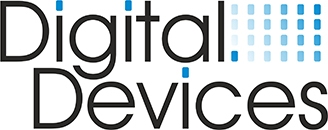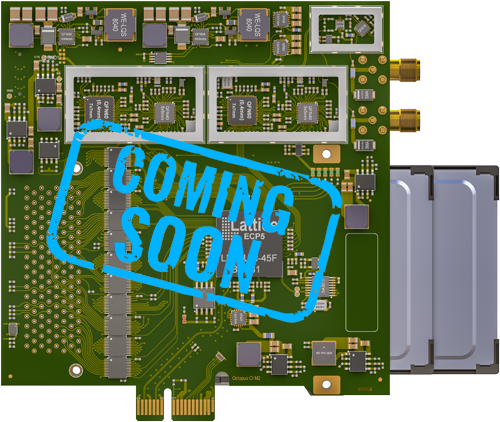The Digital Devices Octopus CI M2 is a multi-standard TV card for the PCI Express slot with two TV tuners and Twin CI Slot.
Compact design, low power consumption and the use of satellite, cable and terrestrial DVB signals characterize the flexible use of the Octopus CI M2 card under Windows® and Linux:
- DVB-S (satellite tuner)
- DVB-S2 (satellite tuner)
- DVB-S2X (satellite tuner)
- ISDB-S (Satellite Tuner)
- ISDB-S3 (satellite tuner)
- DVB-C (cable tuner)
- ISDB-C (cable tuner)
- J.83 Annex B (cable tuner)
- DVB-T (Terrestrial tuner)
- DVB-T2 (Terrestrial tuner)
- ISDB-T (Terrestrial Tuner)
The card can be used with Windows® 7, 8, 10, 11 and Linux operating systems.
Further information on the respective types of reception can be found in the “Specifications” section.
Use both tuners on the card for any type of reception or one tuner each in satellite mixed operation with a broadband cable or terrestrial signal.
To operate both tuners with a broadband cable or terrestrial signal, only one signal cable must be connected to the card. Receiving satellite signals on both tuners requires two signal lines with a standard signal distribution (twin/quad/octo-LNB or external multiswitch).
Like all Digital Devices products, the Octopus CI M2 can also be operated on single-cable systems (SCR – Single Cable Routing). The prerequisite for this is a satellite system (LNB or multi-switch) that works according to the Unicable®1 (EN50494), Unicable-II®/JESS®2 (EN50607) standard.
Notice:
The Unicable protocol offers the advantage of supplying up to 8 participants via one signal cable. With UnicableII®/JESS®, up to 32 participants can be supplied via one signal cable, provided there is a corresponding number of tuners.
Reception from multiple satellites (DiSEqC) is also possible with single-cable systems.
The Twin CI slot installed on the card enables the decryption3 of PayTV content that is not CI+ encrypted. Thanks to MTD technology (Multi Transponder Decryption), multiple channels of different transponder frequencies can be decrypted using just one CI slot. Thanks to CI cascading, both tuners can be used independently for decryption with different smart cards via the second CI slot.
The GTL port (20-pin pin header) on the card ensures that the Octopus CI M2 can be used with all existing and future digital devices systems.
The GTL link is established using a data cable, e.g. for connection to the Octopus NET mainboard, as well as to the Octopus GTL Bridge for miniPCI Express.
Notice:
The GTL port cannot be used to connect previous DuoFlex Twin Tuner expansion cards.
Driver support for Windows® 7, 8, 10, 11 and Linux, for the use of numerous well-known TV applications, such as: DD-TV, Windows® Media Center, DVBViewer, MediaPortal, VDR, Tvheadend, etc.
1 Unicable® Requirement: Unicable®/SCR/CENELEC EN50494 compliant LNB or multiswitch according to EN50494
2 JESS® Requirement: Jess®/CENELEC EN50607 compliant LNB or multiswitch according to EN50607
3 A corresponding smart card from a PayTV content provider and a suitable CA module (CAM) are required for decryption. The general terms and conditions and license terms of the PayTV content providers, as well as the license rights of the rights holders, must be observed.
Unicable® SCR/Cenelec EN50494
- Supports up to 4 tuners with just one antenna cable using Unicable®/ SCR/CENELEC EN50494 compliant LNB or multi switch
JESS©/Cenelec EN50607
- Supports up to 16 tuners with just one antenna cable using CENELEC EN50607 compliant LNB or multi switch
DiSEeqC 2.0 Support
PCIexpress
- Connection via PCIe x1 up to x16 slot
GT-Link Port
- To connect to Octopus NET (Datarate > 1 GBit)
- Notice: Make use of PCIexpress or GT-Link Port
Support of many TV applications
- Microsoft Windows® Media Center 7/8, DVBViewer, Media Portal, Gen2VDR, MythTV
Green IT
- Power consumption of ~ 7 W
- No tantal capacitors
- No electrolyte capacitors
Supported operating systems
- Microsoft Windows® 7/8(.1)/10
- Linux (ab Kernel 2.6.34)
DVB-S
DVB-S2
DVB-S2X
ISDB-S
ISDB-S3
DVB-T
DVB-T2
ISDB-T
DVB-C
ISDB-C
J.83 Annex-B
| DVB-S2/S2X Features |
Max M8i |
Max M8 |
Max SX8 |
Max SX8 Basic |
Max M4 |
| Short Frames | |||||
| Long Frames | |||||
| ACM/VCM | |||||
| MIS | |||||
| Annex M | |||||
| Channel Bonding (S2X) | |||||
| QPSK 1/4,1/3,2/5 | |||||
| QPSK 1/2, 3/5, 2/3, 3/4, 4/5, 8/9, 8/10 | |||||
| QPSK 13/45, 9/20, 11/20 | |||||
| QPSK 11/45, 4/15, 14/45, 7/15, 8/15, 32/45 | |||||
| 8PSK 3/5, 2/3, 3/4, 5/6, 8/9, 9/10 | |||||
| 8PSK 23/36, 25/36, 13/18 | |||||
| 8PSK 7/15, 8/15, 26/45, 32/45 | |||||
| 8APSK-L 5/9, 26/45 | |||||
| 16APSK 2/3, 3/4, 5/6, 8/9, 9/10 | 3 | ||||
| 16APSK 26/45, 3/5, 28/45, 23/36, 13/18, 7/9, 77/90 | |||||
| 16APSK 7/15, 8/15, 26/45, 3/5, 32/45 | |||||
| 16APSK-L 5/9, 8/15, 1/2, 3/5, 2/3 | |||||
| 32APSK 3/4, 4/5, 5/6, 8/9, 9/10 | 3 | ||||
| 32APSK 32/45, 11/15, 7/9 | |||||
| 32APSK 2/3, 32/45 | |||||
| 32APSK-L 2/3 | |||||
| 64APSK 11/15, 7/9, 4/5, 5/6 | |||||
| 64APSK-L 32/45 | |||||
| 128APSK 3/4, 7/9 | |||||
| 256APSK 32/45, 3/4 | |||||
| 256APSK-L 29/45, 2/3, 31/45, 11/15 | |||||
| VL-SNR | |||||
| Maximum Symbolrates (MSymbols/s) |
Max M8i |
Max M8 |
Max SX8 |
Max SX8 Basic |
Max M4 |
| QPSK | 45 | 45 | ~954 | 64.54 | 46 |
| 8PSK/8APSK | 45 | 45 | 864 | 64.54 | 46 |
| 16APSK | 45 | 45 | 64.54 | 34.53 | |
| 32APSK | 40 | 40 | 51.64 | 27.53 | |
| 64APSK | 434 | ||||
| 128APSK | 36.854 | ||||
| 256APSK | 32.254 | ||||
| Annex M | 500 | ||||
| Card Features | |||||
| Demodulators/Channels | 8 | 8 | 8 | 8 | 4 |
| Inputs | 1 | 1 | 4 | 4 | 4 |
| BBFrame Output |
4 Maximum DVB-S2/S2X LDPC bitrate is limited to 720 Mbit/s. This bitrate is defined as symbolrate * bits/symbol, i.e. 8PSK 30 Msymbols = 90 Mbit/s. The used bitrate is dynamically allocated by the driver. DVB-S channels don't contribute to the limit.


